Orolia 8225 Installation guide
- Category
- GPS receiver modules
- Type
- Installation guide
This manual is also suitable for

USA www.spectracomcorp.com | techsupport@spectracomcorp.com | 1565 Jefferson Road STE 460 | Rochester, NY 14623 | +1.585.321.5800
FRANCE www.spectracom.fr | techsupport@spectracom.fr | 3 Avenue du Canada | 91974 Les Ulis, Cedex | +33 (0)1 64 53 39 80
UK www.spectracom.co.uk | techsupport@spectracom.co.uk | 6A Beechwood | Chineham Park | Basingstoke, Hampshire, RG24 8WA | +44 (0)1256 303630
Model 8225 GPS Outdoor Antenna Installation Guide
Rev D, June 2012
/ PN 8225-5000-0050
Spectracom provides one of two different standard GPS antennas with certain GPS-equipped products, including the
Model 8225 (1) antenna and the TSAT dome antenna (2) (the product number
of which varies depending on the board-level timing product with which it
ships). Each antenna is shipped with a mast and clamps for affixing the
antenna to an appropriate structure. The antenna components themselves are
simply screwed together (the appropriate components are threaded). Refer to
the installation instructions herein for proper positioning of your GPS antenna.
NOTE: A free-standing base is sold separately. Contact Spectracom to
order a Model base for your antenna mast.
The Model 8225 is an active GPS antenna tuned to receive 1575.42 MHz L1 band satellite transmissions. The received
signals are passed through a narrow bandpass filter and a preamplifier within the antenna. The active antenna circuitry
provides 30dB of gain and requires +5 VDC at 27 milliamps (provided by a Spectracom GPS receiver over the antenna
cable).
The TSAT dome antenna/receiver is is an active GPS antenna/receiver
operating on the 1575.42 MHz L1 band. It provides continuous tracking with
an update rate of 1 Hz and generates a pulse-per-second (PPS) output
synchronized to UTC within 15 nanoseconds. It also outputs a serial protocol
at RS-422 levels. The receiver requires +5 VDC at 50 milliamps (provided by a
Spectracom board-level product over multi-conductor cable).
Specifications
Installing the Antenna
The GPS antenna must be installed outdoors with an unobstructed view of the
sky (to 20° elevation from the horizon). An unobstructed line of sight to the sky
allows the antenna to locate and track the maximum number of satellites
throughout the day. Installations with obstructed views may still prove
functional, but the equipment may experience reduced reception quality or be
unable to track simultaneously the maximum number of satellites. Make sure
the antenna is installed somewhere that it will not be buried in loose or drifting
snow, or obstructed by growing foliage. Whenever possible, avoid placing the
GPS antenna in close proximity to broadcast antennas.
To connect the antenna, run the antenna cable through the mast if desired or
feasible (4, 8), into the antenna slot up through the end of the mast if not
feasible (5), or simply to the antenna dome (9). The 8225 antenna connection
is made inside the housing and the collar screwed down to secure it (3-6). The
TSAT dome antenna is screwed in (7-9).
8225 Antenna
TSAT Dome Antenna
Type
Active
Active
Frequency
1575.42+/- 15 MHz (L1)
1575.42+/- 15 MHz (L1)
Temp Range
-30 to 85 C
-40 to 85 C
Gain
30dB
N/A
Connector
N type, female
12-pin round
Diameter
3.50 in. (8.9 cm)
3.74 in. (9.5 cm)
Weight
6.8 oz. (191 g)
5.4 oz. (154 g)
4
5
1 2 1 2
3

Spectracom Model 8225 GPS Antenna Installation Guide
Rev D, June 2012 / PN 8225-5000-0050
Page 2 of 5
USA www.spectracomcorp.com | techsupport@spectracomcorp.com | 1565 Jefferson Road STE 460 | Rochester, NY 14623 | +1.585.321.5800
FRANCE www.spectracom.fr | techsupport@spectracom.fr | 3 Avenue du Canada | 91974 Les Ulis, Cedex | +33 (0)1 64 53 39 80
UK www.spectracom.co.uk | techsupport@spectracom.co.uk | 6A Beechwood | Chineham Park | Basingstoke, Hampshire, RG24 8WA | +44 (0)1256 303630
Antenna Cable for Outdoor Antenna
When using the Model 8225 GPS outdoor antenna, Spectracom recommends
using LMR-400 (or equivalent) low loss type cable for the GPS antenna cable.
To simplify the installation process, Spectracom offers GPS cable assemblies
terminated with Type N Male connectors. Standard lengths are 25, 50, 100,
150 and 200 feet.
If the antenna cable is purchased locally, select coax suitable for outdoor use.
Consider the cable's weather ability, temperature range, UV resistance, and
attenuation characteristics.
Do not allow the antenna cable to be placed in standing water, as water may
permeate through the coax jacket over time. On flat roof installations, the coax
can be suspended by cable hangers or placed in sealed PVC conduit. Apply a
weather proofing sealant or tape over all outdoor connections.
Installation of a surge protection device in the antenna line is recommended to
protect the GPS receiver and connected devices from lightning damage.
Spectracom offers the Model 8226 Impulse Suppressor to shunt potentially
damaging voltages on the antenna coax to ground. Note the Model 8226
surge suppressor is only compatible with the Model 8225 GPS antenna. It is
not compatible with the TSAT dome antenna.
Cable Lengths
For the Model 8225 antenna, the maximum recommended antenna cable
length, when installed without a preamplifier, is 300 feet of LMR 400 or
equivalent cable with a maximum attenuation (loss) of 16 dB (Figure 2-1).
When selecting alternate antenna cable sources, the attenuation
characteristics at the GPS frequency of 1575.42 MHz must be known. To
ensure optimum receiver performance, the total antenna cable attenuation
must not exceed 16 dB regardless of cable length. Cable attenuation of greater
than 16 dB requires the use of a Model 8227 Inline Amplifier (Figure 2-2).
Model 8224 GPS Splitter
The GPS Antenna Splitter, Model 8224, is designed for use with an existing
antenna/cable setup. It eliminates the need and expense for a second
antenna/cable run when two synchronization systems are desirable. The
Model 8224 should be installed indoors.
Model 8226 Impulse Suppressor
Spectracom recommends the use of an inline coaxial protector for all products
with an outside antenna. Spectracom offers the Model 8226, Impulse
Suppressor, to protect the receiver from damaging voltages occurring on the
antenna coax. Voltages exceeding the impulse suppresser trip point are
shunted to the system ground. The Model 8226 is designed to withstand
multiple surges.
Two LMR-400 field-installable N type connectors are provided with the Model 8226 to splice in the surge suppressor
wherever it must be placed. However, the recommended method to avoid having to cut the antenna cable is to determine
the desired location of the Model 8226 ahead of time and then order two lengths of pre-terminated cables instead of just
one long cable that spans the entire distance between the antenna and the Spectracom GPS Receiver.
Mount the suppressor indoors, preferably where the coax enters the building. Install the suppressor on a grounding panel
or bulkhead as shown in Figure 2-3. Refer to the Model 8226 Manual for proper installation.
6
9
7
8

Spectracom Model 8225 GPS Antenna Installation Guide
Rev D, June 2012 / PN 8225-5000-0050
Page 3 of 5
USA www.spectracomcorp.com | techsupport@spectracomcorp.com | 1565 Jefferson Road STE 460 | Rochester, NY 14623 | +1.585.321.5800
FRANCE www.spectracom.fr | techsupport@spectracom.fr | 3 Avenue du Canada | 91974 Les Ulis, Cedex | +33 (0)1 64 53 39 80
UK www.spectracom.co.uk | techsupport@spectracom.co.uk | 6A Beechwood | Chineham Park | Basingstoke, Hampshire, RG24 8WA | +44 (0)1256 303630
Spectracom offers a grounding kit that includes grounding cable, clamps, mounting bracket and ground plane. The
Spectracom Part Number for this kit is 8226-0002-0600. Contact our Sales department for additional information.
2-1: Cabling without Inline Amplifier
Figure 2-1: Cabling with Inline Amplifier
Spectracom
GPS Receiver
Model
8226
Model
8227
Model 8225
Install impulse
suppressor between
the antenna and the
amplifier whenever
possible
5 Foot Cable included
300’ Maximum
(LMR 400)
400’ Maximum
(LMR 400)
16 dB Maximum
21 dB Maximum
450’ Minimum, 700’ Maximum
(24 dB Minimum, 37 dB Maximum

Spectracom Model 8225 GPS Antenna Installation Guide
Rev D, June 2012 / PN 8225-5000-0050
Page 4 of 5
USA www.spectracomcorp.com | techsupport@spectracomcorp.com | 1565 Jefferson Road STE 460 | Rochester, NY 14623 | +1.585.321.5800
FRANCE www.spectracom.fr | techsupport@spectracom.fr | 3 Avenue du Canada | 91974 Les Ulis, Cedex | +33 (0)1 64 53 39 80
UK www.spectracom.co.uk | techsupport@spectracom.co.uk | 6A Beechwood | Chineham Park | Basingstoke, Hampshire, RG24 8WA | +44 (0)1256 303630
Figure 2-3: Model 8226 Impulse Suppressor
Model 8227 GPS Inline Amplifier
An inline amplifier is required whenever GPS antenna cable lengths cause greater than 16 dB attenuation. The Model
8227 GPS Inline Amplifier, shown in figure 2-4 extends the maximum cable length. The Model 8227 provides 20 dB of
gain and is powered by the GPS Receiver.
Figure 2-4: Model 8227 Inline Amplifier
Two LMR-400 field-installable N type connectors are provided with the Model 8227 to splice in the amplifier wherever it
must be placed. However, the recommended method to avoid having to cut the antenna cable is to determine the desired
location of the Model 8227 ahead of time and then order two lengths of pre-terminated cables instead of just one long
cable that spans the entire distance between the antenna and the GPS receiver unit.
A five foot N type connector cable is also supplied with the Model 8227 to allow it to be installed after the Model 8226
surge suppressor. The Model 8227 should always be installed after the surge suppressor to prevent lightning or surge
damage to the preamp.
Refer to the Model 8227 Manual for proper installation.

Spectracom Model 8225 GPS Antenna Installation Guide
Rev D, June 2012 / PN 8225-5000-0050
Page 5 of 5
USA www.spectracomcorp.com | techsupport@spectracomcorp.com | 1565 Jefferson Road STE 460 | Rochester, NY 14623 | +1.585.321.5800
FRANCE www.spectracom.fr | techsupport@spectracom.fr | 3 Avenue du Canada | 91974 Les Ulis, Cedex | +33 (0)1 64 53 39 80
UK www.spectracom.co.uk | techsupport@spectracom.co.uk | 6A Beechwood | Chineham Park | Basingstoke, Hampshire, RG24 8WA | +44 (0)1256 303630
Document Revision History
Rev
ECN
Description
Date
A
2213
Document created to include both the 8225 and the TSAT dome antenna,
obsoleting Man8225.
B
2452
Included additional installation information.
C
2702
Updated address information.
October 2011
D
2984
Specification corrections & document maintenance.
June 2012
-
 1
1
-
 2
2
-
 3
3
-
 4
4
-
 5
5
Orolia 8225 Installation guide
- Category
- GPS receiver modules
- Type
- Installation guide
- This manual is also suitable for
Ask a question and I''ll find the answer in the document
Finding information in a document is now easier with AI
Related papers
-
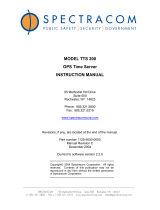 Orolia TTS 200 GPS Time Server User manual
Orolia TTS 200 GPS Time Server User manual
-
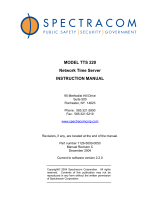 Orolia TTS 220 Network Time Server User manual
Orolia TTS 220 Network Time Server User manual
-
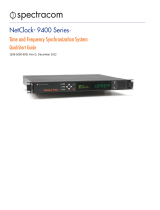 Orolia NetClock 9400 Series Quick start guide
Orolia NetClock 9400 Series Quick start guide
-
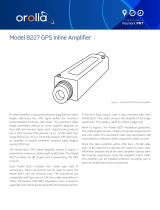 Orolia 8227 GPS Inline Amplifier User manual
Orolia 8227 GPS Inline Amplifier User manual
-
 Orolia Weatherproofing Kit User manual
Orolia Weatherproofing Kit User manual
-
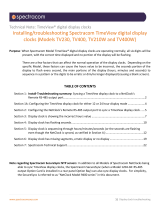 Orolia Installing/ RS-485 synchronized TimeView digital display clocks User manual
Orolia Installing/ RS-485 synchronized TimeView digital display clocks User manual
-
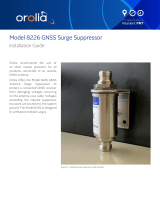 Orolia 8226 GPS Antenna Surge Suppressor User manual
Orolia 8226 GPS Antenna Surge Suppressor User manual
-
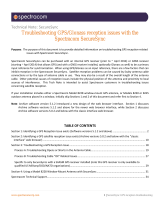 Orolia GPS/GLONASS reception User manual
Orolia GPS/GLONASS reception User manual
-
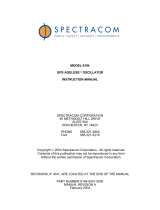 Orolia 8194 GPS Ageless Oscillator User manual
Orolia 8194 GPS Ageless Oscillator User manual
-
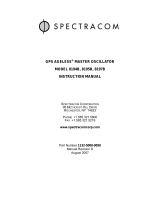 Orolia GPS Ageless Master Oscillator 8194B, 8195B, 8197B User manual
Orolia GPS Ageless Master Oscillator 8194B, 8195B, 8197B User manual














